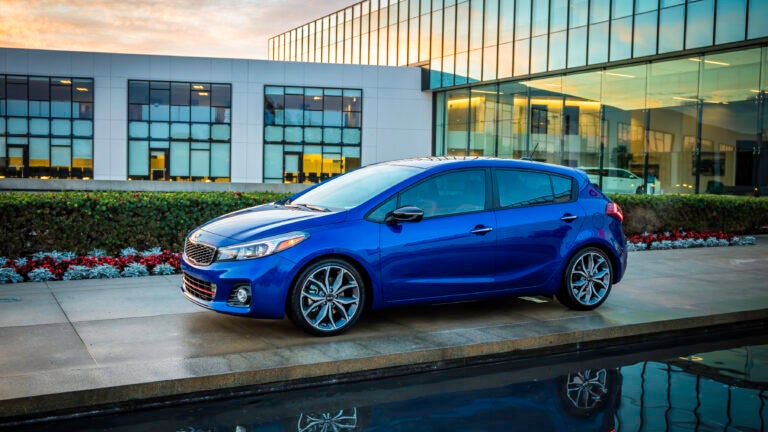Vehicles
John Paul, AAA Northeast’s Automotive Physician, solutions a query from a reader on the lookout for quieter tires.

Q. I’m a former mechanic who additionally labored within the elements division for a GM automobile supplier for over 30 years, so I do know a bit about vehicles. I’m retired and have a 2018 KIA Forte5 SX and would really like a softer trip than the 40 Sequence tires give. What can I do to get a softer and quieter trip?
A. I believe you might be caught with the agency sport trip you’ve gotten. The 40 Sequence tire doesn’t provide you with a lot selection. On much less sporty fashions, there’s a 17-inch wheel 45 Sequence, and I’m undecided the cash spent on new wheels could be price it. The trip is kind of decided by the peak of the sidewall. Shifting to a 235/45R18 is simply going to achieve .3 or .4 of an inch of sidewall whereas nonetheless preserving about the identical total diameter, and would possibly provide you with a slight enchancment in trip high quality. When purchasing for tires I’d additionally search for critiques that particularly point out a quiet trip.
Q. I’ve a 1998 Lexus ES with 155,000 miles. The timing belt was final modified 8.5 years and 40,000 miles in the past. The handbook calls for six years and 90,000 miles. Ought to I’m going by time or mileage to find out when to vary it? The automobile is at all times garaged and goes about 6,000 miles a yr.
A. It’s totally doable that the timing belt is in good situation, however there isn’t a strategy to know except you really examine it. Rubber timing belts (and lots of rubber elements) can fail on account of mileage and age. If this had been my 25-year-old Lexus and I deliberate on preserving it for some time, to be secure, and to have a reliable automobile, I’d exchange the timing belt.
Q. I’ve a couple of questions in regards to the insulation utilized in Honda automobile wiring. From what I perceive, the insulation of Honda automobile wiring is soy-based. I’ve been the sufferer of critters consuming the wiring of my Honda automobile, and the expense of getting it repaired. Now that Honda is aware of that little animals prefer to eat their soy-based wiring insulation, has Honda switched to another wiring insulation, or are they nonetheless manufacturing new Honda vehicles whose wiring they know can be eaten by critters?
A. I, too, thought the soy-based wiring was a problem, however after speaking to engineers at Honda, Ford, and Toyota, though the insulation is soy primarily based it isn’t a meals grade of fabric. The earlier materials was petroleum primarily based, and the soy-based materials was developed to be extra environmentally pleasant. In lots of vehicles the seat cushions are additionally soy primarily based. We lately had one in all our AAA vans not begin, and the problem was an enormous nest beneath the hood. On this case primarily based on the nest it was probably an opossum. Since rodents and squirrels chew by means of home and business wiring, partitions, and different constructing supplies, I don’t suppose the insulation is the problem. I believe the rodent downside is simply that, a rodent downside. As we construct extra and take over open house, these damaging critters transfer into our automobiles.
Q. I’m having an issue with my 2018 Hyundai Tucson. It seems to be guzzling oil. Hyundai accomplished an oil consumption take a look at and located it to be inside vary, so they won’t repair it. Consequently, I must have my oil modified each 2,000-2,500 miles or it fully runs out. A fast Google search advised me that there’s a class motion lawsuit from different Hyundai and Kia house owners with the identical downside, however Hyundai doesn’t acknowledge that it’s a downside. Any recommendation? Getting an oil change each two months is a large inconvenience.
A. I’d proceed to work with Hyundai on this situation. Hyundai’s guideline on oil consumption is that if the engine makes use of multiple quart of oil in 1,000 miles, the engine is changed. Based mostly in your feedback that the engine runs out of oil each 2,500 miles, your automobile’s engine ought to qualify for engine alternative. Within the interim, you don’t want to vary the oil each 2,500 miles, however you do must examine the oil periodically and add as essential to hold the engine correctly lubricated.
John Paul is AAA Northeast’s Automotive Physician. He has over 40 years of expertise within the automotive enterprise and is an ASE-certified grasp technician. E-mail your Automotive Physician query to [email protected] Hearken to the Automotive Physician podcast at johnfpaul.podbean.com.
Publication Signup
Keep updated on all the newest information from Boston.com
Originally posted 2023-05-15 20:32:32.